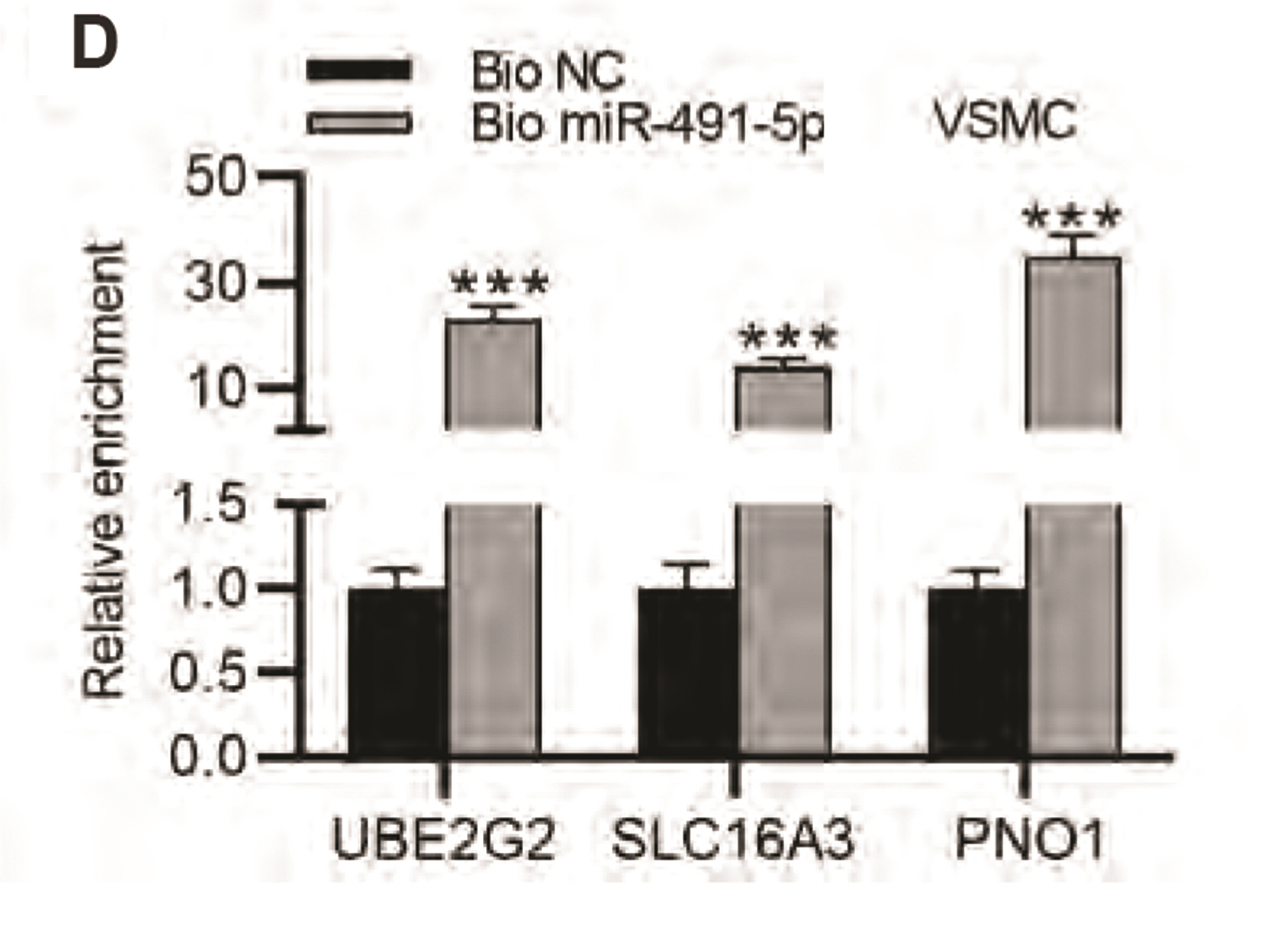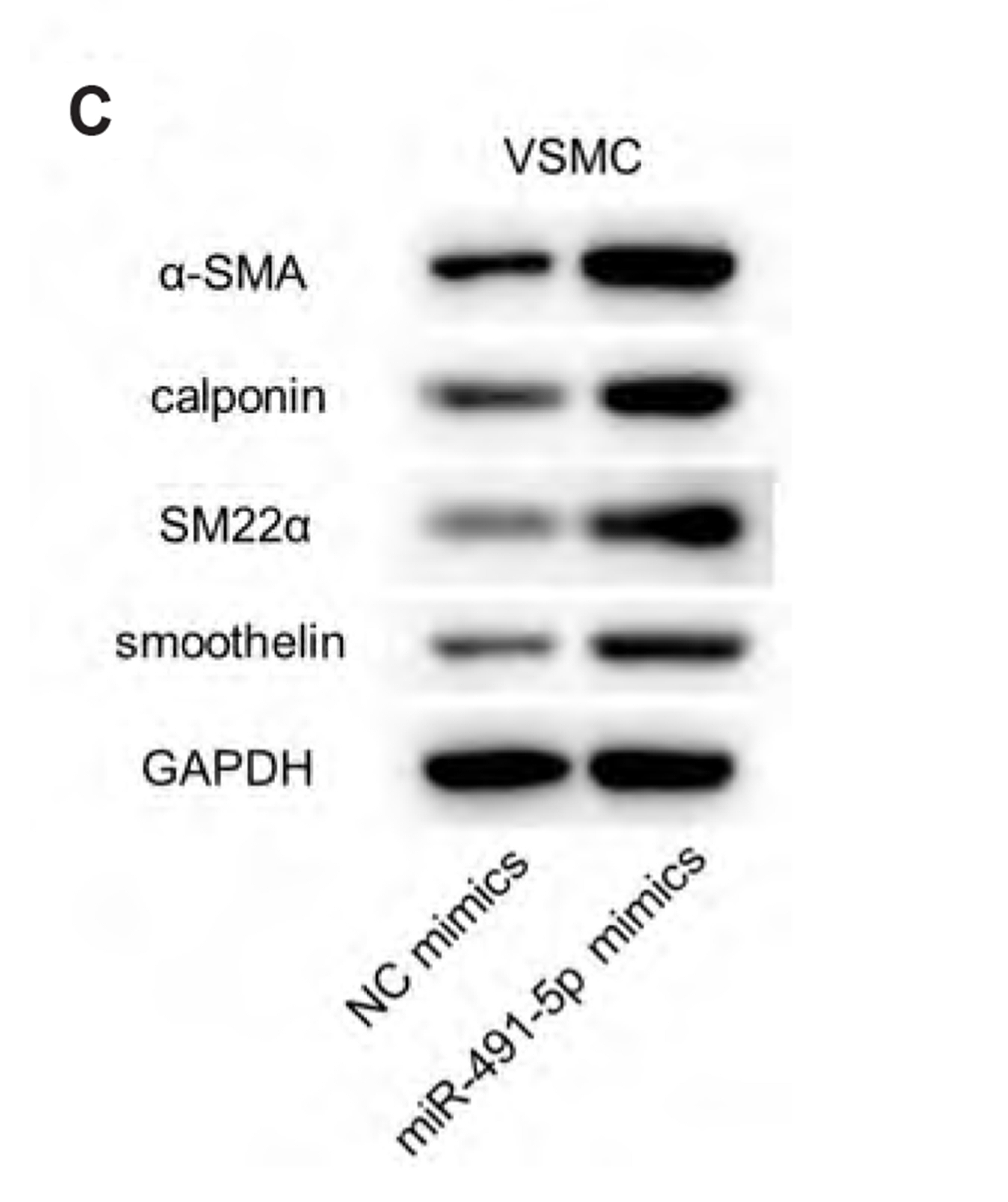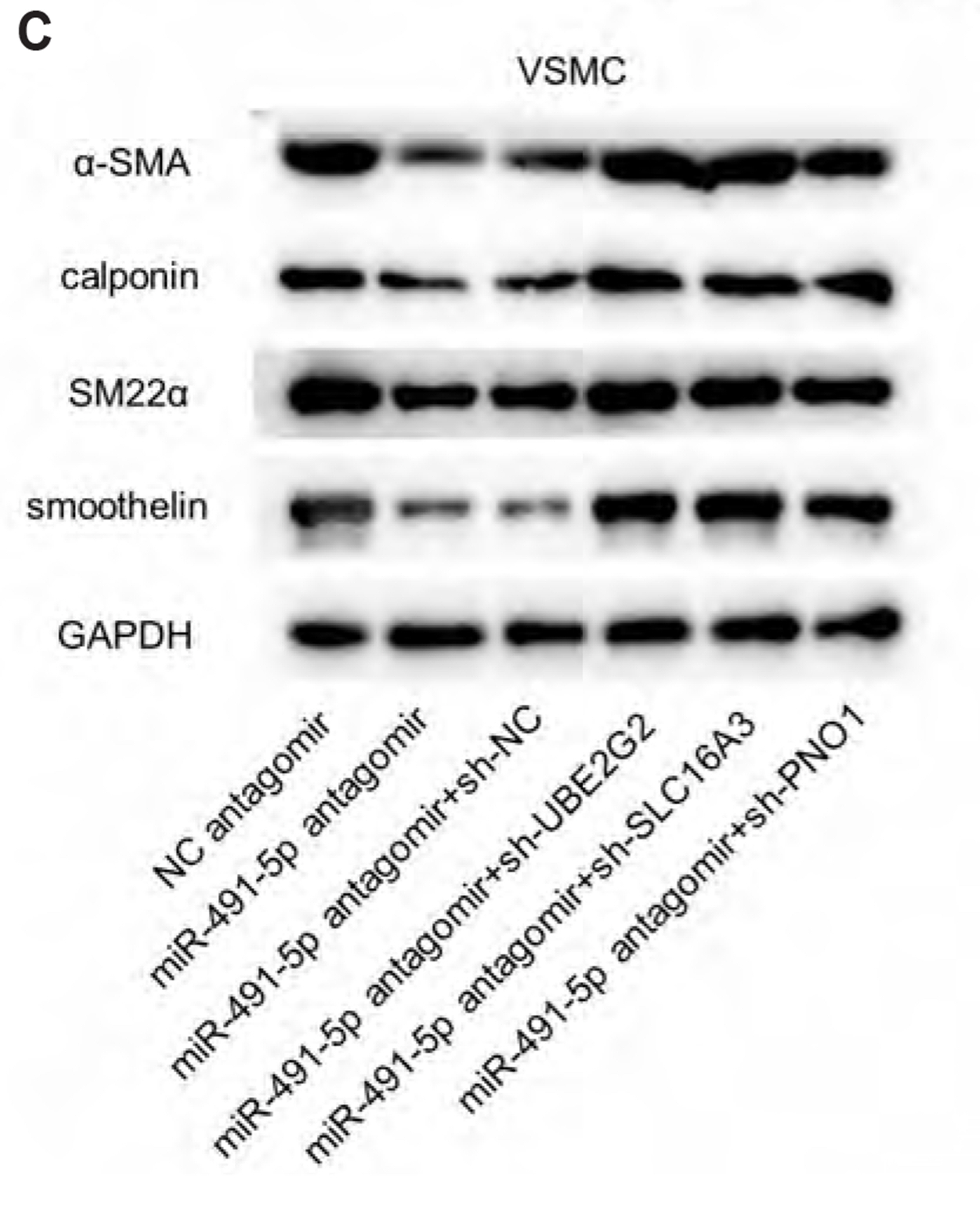Korean J Physiol Pharmacol.
2022 May;26(3):183-193. 10.4196/kjpp.2022.26.3.183.
Differentially expressed mRNAs and their upstream miR-491-5p in patients with coronary atherosclerosis as well as the function of miR-491-5p in vascular smooth muscle cells
- Affiliations
-
- 1Department of Cardiovascular Surgery, The Affiliated Huaian No. 1 People’s Hospital of Nanjing Medical University, Huaian, Jiangsu 223300, China
- KMID: 2529401
- DOI: http://doi.org/10.4196/kjpp.2022.26.3.183
Abstract
- MicroRNAs (miRNAs) regulate gene expression and are biomarkers for coronary atherosclerosis (AS). A novel miRNA-mRNA regulation network of coronary AS still needs to be disclosed. The aim of this study was to analyze potential mRNAs in coronary AS patients and the role of their upstream miR-491-5p in vascular smooth muscle cells (VSMCs). We first confirmed top ten mRNAs according to the analysis from Gene Expression Omnibus database (GSE132651) and examined the expression levels of them in the plaques and serum from AS patients. Five mRNAs (UBE2G2, SLC16A3, POLR2C, PNO1, and AMDHD2) presented significantly abnormal expression in both plaques and serum from AS patients, compared with that in the control groups. Subsequently, they were predicted to be targeted by 11 miRNAs by bioinformatics analysis. Among all the potential upstream miRNAs, only miR-491-5p was abnormally expressed in the plaques and serum from AS patients. Notably, miR-491-5p overexpression inhibited viability and migration, and significantly increased the expression of contractile markers (α-SMA, calponin, SM22α, and smoothelin) in VSMCs. While silencing miR-491-5p promoted viability and migration, and significantly suppressed the expression of α-SMA, calponin, SM22α, and smoothelin. Overall, miR-491-5p targeted UBE2G2, SLC16A3, and PNO1 and regulated the dysfunctions in VSMCs.
Keyword
Figure
Cited by 2 articles
-
Rosuvastatin activates autophagy
via inhibition of the Akt/mTOR axis in vascular smooth muscle cells
Seongpyo Lee, Do-Hyung Lee, Jin-Pyo Lee, Joo-Hui Han
Korean J Physiol Pharmacol. 2025;29(1):117-126. doi: 10.4196/kjpp.24.284.Monotropein resists atherosclerosis by reducing inflammation, oxidative stress, and abnormal proliferation and migration of vascular smooth muscle cells
Hongliang Li, Bingqian Ye, Jiping Tian, Bofan Wang, Yiwen Zha, Shuying Zheng, Tan Ma, Wenwen Zhuang, Won Sun Park, Jingyan Liang
Korean J Physiol Pharmacol. 2025;29(2):245-255. doi: 10.4196/kjpp.24.352.
Reference
-
1. Ou H, Liu C, Feng W, Xiao X, Tang S, Mo Z. 2018; Role of AMPK in atherosclerosis via autophagy regulation. Sci China Life Sci. 61:1212–1221. DOI: 10.1007/s11427-017-9240-2. PMID: 29656339.
Article2. Boudoulas KD, Triposciadis F, Geleris P, Boudoulas H. 2016; Coronary atherosclerosis: pathophysiologic basis for diagnosis and management. Prog Cardiovasc Dis. 58:676–692. DOI: 10.1016/j.pcad.2016.04.003. PMID: 27091673.
Article3. Bennett MR, Sinha S, Owens GK. 2016; Vascular smooth muscle cells in atherosclerosis. Circ Res. 118:692–702. DOI: 10.1161/CIRCRESAHA.115.306361. PMID: 26892967. PMCID: PMC4762053.
Article4. Wang J, Uryga AK, Reinhold J, Figg N, Baker L, Finigan A, Gray K, Kumar S, Clarke M, Bennett M. 2015; Vascular smooth muscle cell senescence promotes atherosclerosis and features of plaque vulnerability. Circulation. 132:1909–1919. DOI: 10.1161/CIRCULATIONAHA.115.016457. PMID: 26416809.
Article5. Johnson JL. 2014; Emerging regulators of vascular smooth muscle cell function in the development and progression of atherosclerosis. Cardiovasc Res. 103:452–460. DOI: 10.1093/cvr/cvu171. PMID: 25053639.
Article6. Hutcheson JD, Goettsch C, Bertazzo S, Maldonado N, Ruiz JL, Goh W, Yabusaki K, Faits T, Bouten C, Franck G, Quillard T, Libby P, Aikawa M, Weinbaum S, Aikawa E. 2016; Genesis and growth of extracellular-vesicle-derived microcalcification in atherosclerotic plaques. Nat Mater. 15:335–343. DOI: 10.1038/nmat4519. PMID: 26752654. PMCID: PMC4767675.
Article7. Jiang XI, Luo Y, Zhao S, Chen Q, Jiang C, Dai Y, Chen Y, Cao Z. 2015; Clinical significance and expression of microRNA in diabetic patients with erectile dysfunction. Exp Ther Med. 10:213–218. DOI: 10.3892/etm.2015.2443. PMID: 26170937. PMCID: PMC4486873.
Article8. Zhu N, Zhang D, Chen S, Liu X, Lin L, Huang X, Guo Z, Liu J, Wang Y, Yuan W, Qin Y. 2011; Endothelial enriched microRNAs regulate angiotensin II-induced endothelial inflammation and migration. Atherosclerosis. 215:286–293. DOI: 10.1016/j.atherosclerosis.2010.12.024. PMID: 21310411.
Article9. Ambros V. 2004; The functions of animal microRNAs. Nature. 431:350–355. DOI: 10.1038/nature02871. PMID: 15372042.
Article10. Ndrepepa G, Colleran R, Kastrati A. 2018; Gamma-glutamyl transferase and the risk of atherosclerosis and coronary heart disease. Clin Chim Acta. 476:130–138. DOI: 10.1016/j.cca.2017.11.026. PMID: 29175647.
Article11. Xu Z, Han Y, Liu J, Jiang F, Hu H, Wang Y, Liu Q, Gong Y, Li X. 2015; miR-135b-5p and miR-499a-3p promote cell proliferation and migration in atherosclerosis by directly targeting MEF2C. Sci Rep. 5:12276. DOI: 10.1038/srep12276. PMID: 26184978. PMCID: PMC4505325.
Article12. Zhang R, Sui L, Hong X, Yang M, Li W. 2017; miR-448 promotes vascular smooth muscle cell proliferation and migration in through directly targeting MEF2C. Environ Sci Pollut Res Int. 24:22294–22300. DOI: 10.1007/s11356-017-9771-1. PMID: 28799067.
Article13. Lin B, Feng DG, Wang F, Wang JX, Xu CG, Zhao H, Cheng ZY. 2016; miR-365 participates in coronary atherosclerosis through regulating IL-6. Eur Rev Med Pharmacol Sci. 20:5186–5192. PMID: 28051250.14. Lu L, Cai M, Peng M, Wang F, Zhai X. 2019; miR-491-5p functions as a tumor suppressor by targeting IGF2 in colorectal cancer. Cancer Manag Res. 11:1805–1816. DOI: 10.2147/CMAR.S183085. PMID: 30863186. PMCID: PMC6391127.15. Guo J, Luo C, Yang Y, Dong J, Guo Z, Yang J, Lian H, Ye C, Liu M. 2021; miR-491-5p, as a tumor suppressor, prevents migration and invasion of breast cancer by targeting ZNF-703 to regulate AKT/mTOR pathway. Cancer Manag Res. 13:403–413. DOI: 10.2147/CMAR.S279747. PMID: 33488122. PMCID: PMC7816048.
Article16. Sun R, Liu Z, Tong D, Yang Y, Guo B, Wang X, Zhao L, Huang C. 2017; miR-491-5p, mediated by Foxi1, functions as a tumor suppressor by targeting Wnt3a/β-catenin signaling in the development of gastric cancer. Cell Death Dis. 8:e2714. DOI: 10.1038/cddis.2017.134. PMID: 28358374. PMCID: PMC5386537.
Article17. He Z, Wang Y, He Q, Chen M. 2020; microRNA-491-5p protects against atherosclerosis by targeting matrix metallopeptidase-9. Open Med (Wars). 15:492–500. DOI: 10.1515/med-2020-0047. PMID: 33313408. PMCID: PMC7706122.
Article18. Yuan M, Zhan Q, Duan X, Song B, Zeng S, Chen X, Yang Q, Xia J. 2013; A functional polymorphism at miR-491-5p binding site in the 3'-UTR of MMP-9 gene confers increased risk for atherosclerotic cerebral infarction in a Chinese population. Atherosclerosis. 226:447–452. DOI: 10.1016/j.atherosclerosis.2012.11.026. PMID: 23257658.
Article19. Woo CC, Liu W, Lin XY, Dorajoo R, Lee KW, Richards AM, Lee CN, Wongsurawat T, Nookaew I, Sorokin V. 2019; The interaction between 30b-5p miRNA and MBNL1 mRNA is involved in vascular smooth muscle cell differentiation in patients with coronary atherosclerosis. Int J Mol Sci. 21:11. DOI: 10.3390/ijms21010011. PMID: 31861407. PMCID: PMC6982107.
Article20. Bartel DP. 2004; MicroRNAs: genomics, biogenesis, mechanism, and function. Cell. 116:281–297. DOI: 10.1016/S0092-8674(04)00045-5. PMID: 14744438.21. Song Z, Li G. 2010; Role of specific microRNAs in regulation of vascular smooth muscle cell differentiation and the response to injury. J Cardiovasc Transl Res. 3:246–250. DOI: 10.1007/s12265-010-9163-0. PMID: 20543900. PMCID: PMC2883267.
Article22. Chen Q, Yang F, Guo M, Wen G, Zhang C, Luong le A, Zhu J, Xiao Q, Zhang L. 2015; miRNA-34a reduces neointima formation through inhibiting smooth muscle cell proliferation and migration. J Mol Cell Cardiol. 89(Pt A):75–86. DOI: 10.1016/j.yjmcc.2015.10.017. PMID: 26493107.
Article23. Davis-Dusenbery BN, Wu C, Hata A. 2011; Micromanaging vascular smooth muscle cell differentiation and phenotypic modulation. Arterioscler Thromb Vasc Biol. 31:2370–2377. DOI: 10.1161/ATVBAHA.111.226670. PMID: 22011749. PMCID: PMC4429757.
Article24. Albinsson S, Sessa WC. 2011; Can microRNAs control vascular smooth muscle phenotypic modulation and the response to injury? Physiol Genomics. 43:529–533. DOI: 10.1152/physiolgenomics.00146.2010. PMID: 20841497. PMCID: PMC3110893.
Article25. Tabas I. 2010; Macrophage death and defective inflammation resolution in atherosclerosis. Nat Rev Immunol. 10:36–46. DOI: 10.1038/nri2675. PMID: 19960040. PMCID: PMC2854623.
Article26. Libby P, Ridker PM, Hansson GK. 2011; Progress and challenges in translating the biology of atherosclerosis. Nature. 473:317–325. DOI: 10.1038/nature10146. PMID: 21593864.
Article27. Pordzik J, Pisarz K, De Rosa S, Jones AD, Eyileten C, Indolfi C, Malek L, Postula M. 2018; The potential role of platelet-related microRNAs in the development of cardiovascular events in high-risk populations, including diabetic patients: a review. Front Endocrinol (Lausanne). 9:74. DOI: 10.3389/fendo.2018.00074. PMID: 29615970. PMCID: PMC5869202.
Article28. Fasolo F, Di Gregoli K, Maegdefessel L, Johnson JL. 2019; Non-coding RNAs in cardiovascular cell biology and atherosclerosis. Cardiovasc Res. 115:1732–1756. DOI: 10.1093/cvr/cvz203. PMID: 31389987. PMCID: PMC7967706.
Article29. Hueso M, Mallén A, Casas Á, Guiteras J, Sbraga F, Blasco-Lucas A, Lloberas N, Torras J, Cruzado JM, Navarro E. 2020; Integrated miRNA/mRNA counter-expression analysis highlights oxidative stress-related genes CCR7 and FOXO1 as blood markers of coronary arterial disease. Int J Mol Sci. 21:1943. DOI: 10.3390/ijms21061943. PMID: 32178422. PMCID: PMC7139611.
Article30. He Y, Lin L, Cao J, Mao X, Qu Y, Xi B. 2015; Up-regulated miR-93 contributes to coronary atherosclerosis pathogenesis through targeting ABCA1. Int J Clin Exp Med. 8:674–681. PMID: 25785043. PMCID: PMC4358498.31. Fan JL, Zhang L, Bo XH. 2020; miR-126 on mice with coronary artery disease by targeting S1PR2. Eur Rev Med Pharmacol Sci. 24:893–904. DOI: 10.26355/eurrev_202001_20074. PMID: 32016996.
- Full Text Links
- Actions
-
Cited
- CITED
-
- Close
- Share
- Similar articles
-
- MicroRNA-139-5p Regulates Fibrotic Potentials via Modulation of Collagen Type 1 and Phosphorylated p38 MAPK in Uterine Leiomyoma
- Role of miRNA-324-5p-Modified Adipose-Derived Stem Cells in Post-Myocardial Infarction Repair
- Clinical Significance of miR-21-5p in Predicting Occurrence and Progression of Uremic Vascular Calcification in Patients with End-Stage Renal Disease
- The Role of miR-34c-5p in Osteogenic Differentiation of Bone Marrow Mesenchymal Stem Cells
- MSCs-Derived miR-150-5p-Expressing Exosomes Promote Skin Wound Healing by Activating PI3K/AKT Pathway through PTEN







